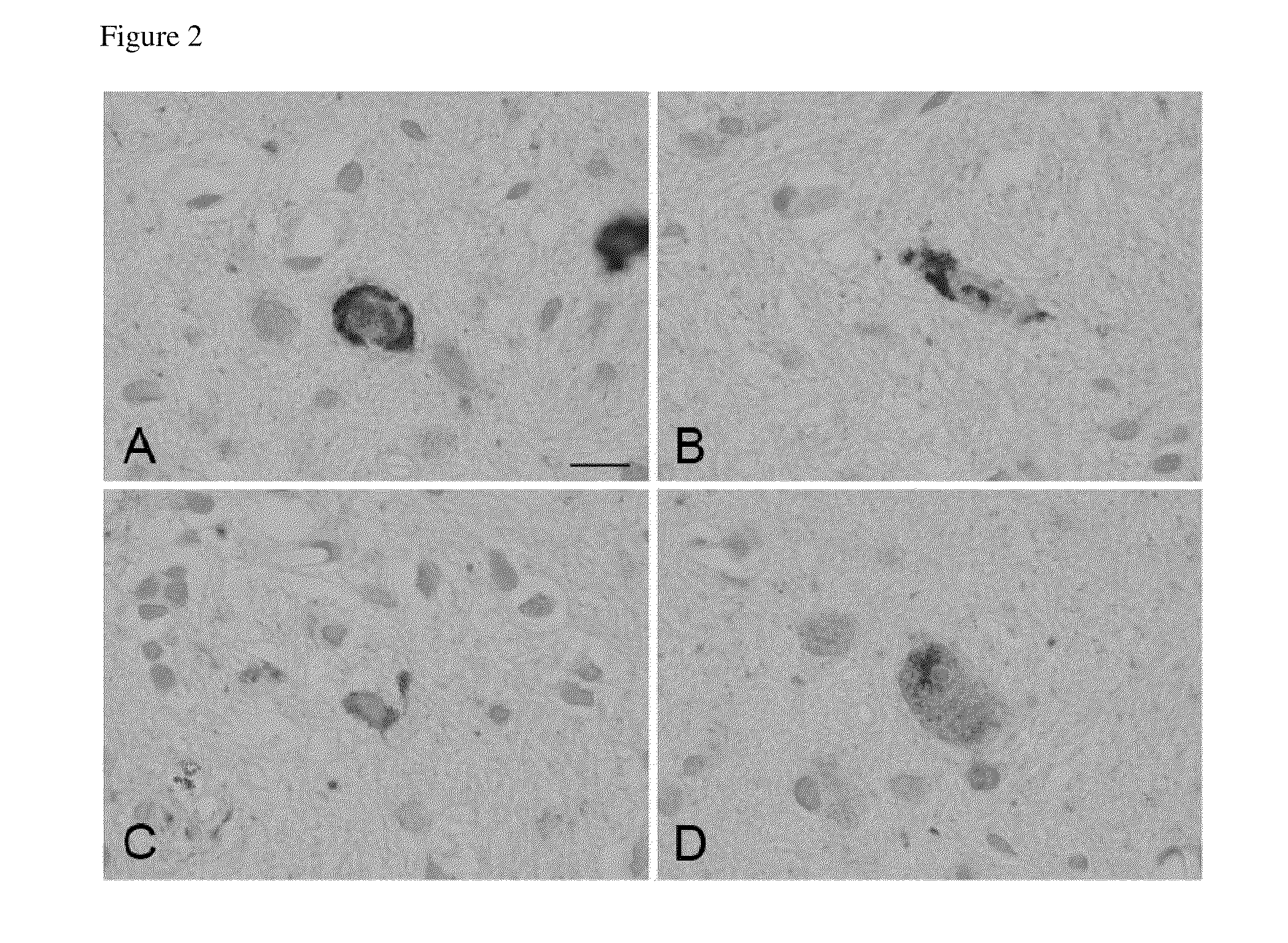Assays of neurodegenerative disorders, including frontotemporal dementia and amyotrophic lateral sclerosis
- Summary
- Abstract
- Description
- Claims
- Application Information
AI Technical Summary
Benefits of technology
Problems solved by technology
Method used
Image
Examples
example 1
Rat TDP-43 Assay
[0099]In order to expand FTLD modeling to a major fraction (50%) of the disease population, TDP-43 in was expressed rats, and a highly specific toxic gene product was observed, causing neuronal cell loss more readily than tau. The human wild type TDP-43 mainly expressed in neuronal nuclei as expected, but a small fraction of the transduced cells (estimated to be 1-2% of the total) expressed TDP-43 in the cytoplasm. Three such examples are shown at high power in FIG. 8A-C, with one example from the GFP group in FIG. 8D, using an antibody that recognizes both rat and human TDP-43. TDP-43 positive nuclei are in both groups, whereas the protein is only expressed cytoplasmically in the TDP-43 group, with diffuse and granular immunoreactivity at an interval of 4 weeks. Cytoplasmic ubiquitin deposition only occurred in the TDP-43 group, in the areas that had the cytoplasmic TDP-43 (FIG. 8H). There was evidence of abiotrophic, pyknotic degeneration by hematoxylin & eosin sta...
example 2
TDP-43 Expression in the Hypoglossal Nucleus
[0102]a) An assay which mimics symptoms of bulbar onset ALS can be provided using the methods for TDP-43 gene transfer to the hypoglossal nucleus disclosed herein. It is contemplated that focal delivery of TDP-43 to the rat hypoglossal nucleus will mimic a specific symptom of bulbar onset ALS (Eisen, 2009; DePaul et al., 1988) as described herein. Bulbar onset ALS with dysarthria has a particularly poor prognosis due to aspiration of food (Tomik and Guiloff, 2008). Dysarthria, or motor dysfunction of the mouth, is a key symptom of bulbar onset ALS, where the face, and talking, are affected (DePaul et al., 1988). The hypoglossal injections of AAV9 TDP-43 into rats induces a robust phenotype of decreased lick force, reminiscent of dysarthria.
[0103]The methods disclosed below test whether TDP-43 variants (NLS TDP, TDP-25) designed for cytoplasmic expression will also impair lick force. It is contemplated that while TDP-43 expression directed ...
example 3
Intravenous Administration of TDP-43 AAV9
[0108]It is contemplated that widespread TDP-43 expression from intravenous vector delivery is relevant to diseases with widespread pathology. A method for gene transfer to the spinal cord, brain stem, and brain via intravenous vector administration is thus provided.
[0109]a) One day old rat pups were injected with GFP or TDP-43 AAV9 via the temporal vein with a 30 ga. needle. A high dose of AAV9 TDP-43 in neonatal rats caused a severe and rapid disease state as early as 3 weeks. Therefore, a low dose (9×10E11 vg) should permit a slower pathogenesis. Transduced rats can be maintained for 6 months for evaluating their behavior, as well as overall health and weight gain over 6 months. Behavioral testing intervals can be at 1, 2, 3, and 6 months before histological analysis at that interval, with 12 rats per group. Each vector group can have 6 rats sacrificed at 1 month for histology, which would not be run for behavior.
[0110]A dose-response can ...
PUM
| Property | Measurement | Unit |
|---|---|---|
| Fraction | aaaaa | aaaaa |
| Fraction | aaaaa | aaaaa |
| Fraction | aaaaa | aaaaa |
Abstract
Description
Claims
Application Information
 Login to View More
Login to View More - R&D
- Intellectual Property
- Life Sciences
- Materials
- Tech Scout
- Unparalleled Data Quality
- Higher Quality Content
- 60% Fewer Hallucinations
Browse by: Latest US Patents, China's latest patents, Technical Efficacy Thesaurus, Application Domain, Technology Topic, Popular Technical Reports.
© 2025 PatSnap. All rights reserved.Legal|Privacy policy|Modern Slavery Act Transparency Statement|Sitemap|About US| Contact US: help@patsnap.com



